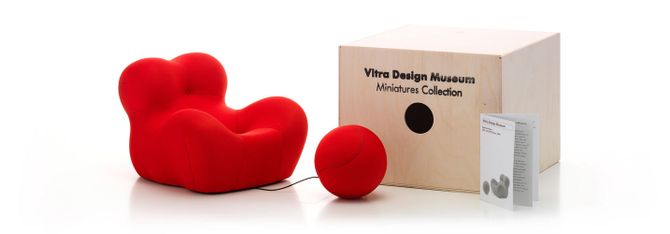
Miniatures Collection - La Mamma
Gaetano Pesce, 1969
Together they succeeded in marking a radical break from traditional upholstery production thanks to the technology developed by C & B Italia for creating oversized foam parts. Donna consists of a molded monoblock of foam withut any supporting structure since the foam rubber is dense and free-standing. First a finished piece of furniture covered with elastic nylon jersey is reduced in a vacuum chamber to about 10% of its normal volume and is then wrapped in airtight foil. The customer can easily transport the otherwise unwieldy piece single-handedly. After removal of the wrapper at the destination, the chair slowly recoveres its original shape without outside help as air seeps back into the capillaries of the polyurethane foam.
Miniatures Collection
Durante más de dos décadas, el Vitra Design Museum ha hecho réplicas en miniatura de las piezas más importantes de su colección. La Miniatures Collection es un compendio de la historia del diseño de mobiliario industrial, desde el Historicismo y el Art Nouveau hasta la Bauhaus y la Nueva Objetividad, desde el Diseño Radical y el Posmodernismo hasta nuestros días. Con un tamaño que es exactamente un sexto del de los originales históricos, las sillas son fieles a la escala y reproducen hasta el menor detalle de construcción, material y color. La autenticidad llega incluso a la veta natural de la madera y a la reproducción de los tornillos y las complejas técnicas artesanales utilizadas. Por este motivo, las miniaturas se han convertido en objetos de colección muy populares y en un material didáctico ideal para universidades, escuelas de diseño y arquitectos.